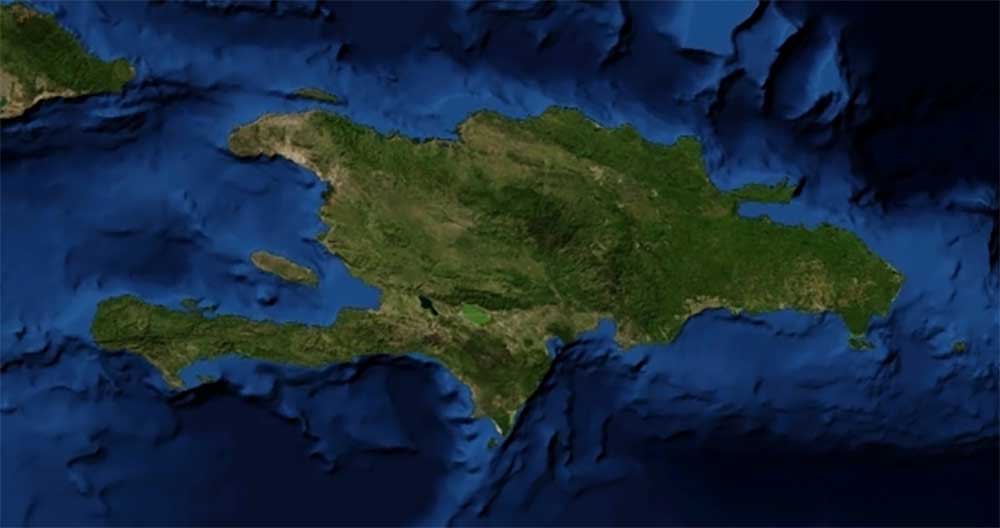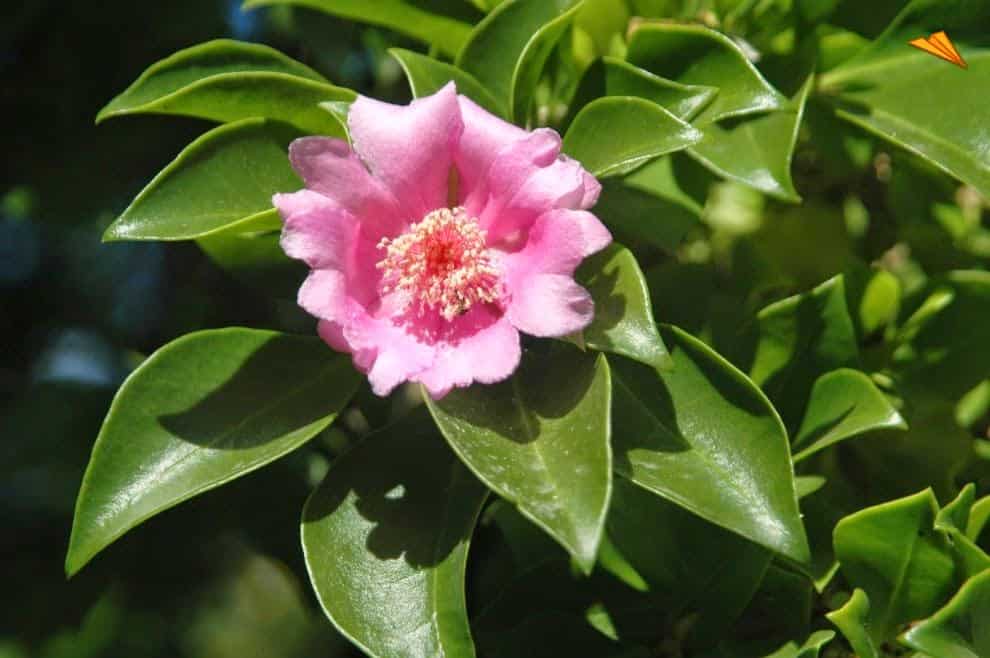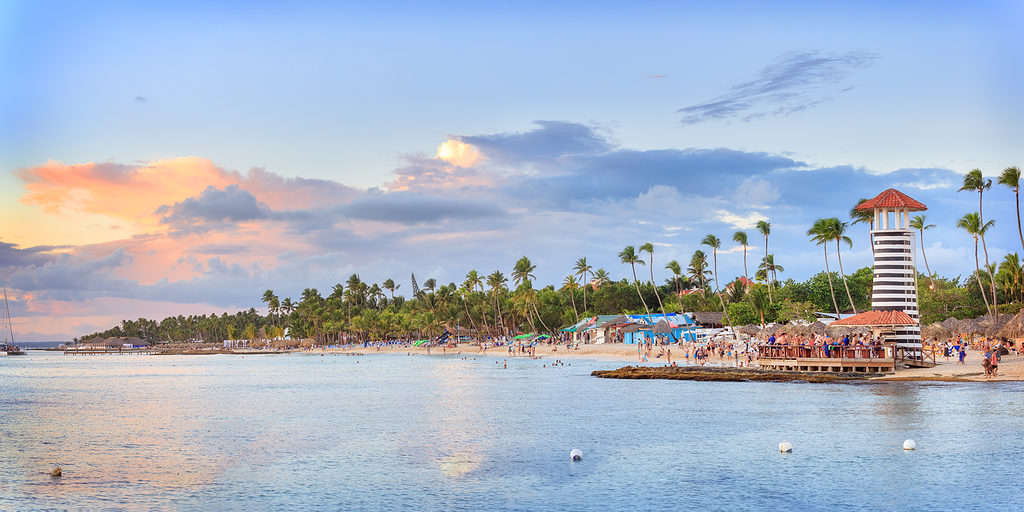The Dominican Republic is an island nation in the Caribbean that shares the island of Hispaniola with the country of Haiti. The Dominican Republic takes up the eastern side of the island and is 18,704 square miles. Despite being a small country, the Dominican Republic is geographically diverse. This country has large, white sandy beaches, dense, evergreen forests, and lush, fertile valleys. It even has desert areas with sandy dunes. As a tropical island, this country is warm and humid year-round, making it a hospitable place for diverse and rare plant and animal species to flourish. Among these is the national flower of the Dominican Republic: The Bayahibe rose. Let’s learn about its appearance, where it grows, its cultural significance, and the role that it plays in Dominican culture!
About the Dominican Republic

The island of Hispaniola contains thousands of different species of reptiles, mammals, birds, and amphibians.
©ILA-boy, GPL <http://www.gnu.org/licenses/gpl.html>, via Wikimedia Commons – License
Even though it is a small country, the Dominican Republic is home to rich biodiversity. The island of Hispaniola contains thousands of different species of birds, reptiles, mammals, and amphibians. In addition to this, the island is home to many more thousands of plant species. More than 2,000 of these are endemic to the Dominican Republic. Among them is a rare kind of cactus. This plant’s blossom is the Bayahibe rose.
What is the National Flower of the Dominican Republic?
Each country’s national flower is a representation of its location, along with its history and its people. The Bayahibe rose is no different. It certainly has a unique position as the national flower of the Dominican Republic. For one thing, the Bayahibe rose grows only on the island of Hispaniola. The government considers it an endangered species. Because of that, you may not have ever heard of this unique flowering plant species before.
This special rose is known as the species Leuenbergeria quisqueyana. It gained this name in part because the country is also referred to as “Quisqueyana.” However, the plant is more commonly known as the Bayahibe rose. Leuenbergeria quisqueyana is the species of cactus it flowers from. It grows across both the Dominican Republic and Haiti, but you will not find it growing natively anywhere else. This cactus plant produces bright pink flowers called Bayahibe roses. These gorgeous blooms were chosen to be the Dominican Republic’s national flower in 2011.
Sadly, the Bayahibe rose is not only rare, but is also an endangered species. In 2011, as the rose was designated the national flower, a specific law was put into effect. This law requires that the Dominican Ministry of the Environment and Natural Resources, Ministry of Education, and National Botanical Garden find ways to protect the species. These agencies share responsibility for preserving the plant and reproducing it in order to keep the species alive.

The Bayahibe rose is not only rare, but is also an endangered species.
©990 × 658 pixels, file size: 98 KB, MIME type: image/jpeg – License
What is the Bayahibe Rose?
The species Leuenbergeria quisqueyana is a member of the Cactaceae, or cactus family. Interestingly, the Bayahibe rose is rare in that it is one of only a few cactus species that bear leaves. This gives the plant a unique appearance. Unlike other cactuses, this plant looks more like a shrub. It usually grows to be medium or large in size, commonly reaching 10 feet high and 2 to 5 feet wide. However, these cacti can grow to be taller.
This shrub-like plant has a trunk with spines that grow into branches. These branches bear bright green leaves and produce bright pink flowers on their ends. This cactus also produces yellow fruits full of black seeds.
As a rare leaf-bearing cactus that only grows on the island of Hispaniola, the Bayahibe rose is unique indeed!
Where Does the Bayahibe Rose Grow?

Bayahibe is a small town turned tourist destination on the southeast side of the island of Hispaniola.
©Lena Serditova/Shutterstock.com
The species gained its nickname because it grows in the wild near Bayahibe, a small town turned tourist destination on the southeast side of the island of Hispaniola. This former fishing village has been transformed into a tropical destination where Dominicans and visitors enjoy Caribbean beaches. Here, the Bayahibe rose still grows in abundance. As a visitor, you’ll see the pink flowers in the wild as well as in local gardens. You could also visit the Bayahibe Rose Garden, which sits on the edge of the water.
As a cactus, the Bayahibe rose thrives when grown in conditions of full sun. It needs moderately moist soil that drains well. As a species native to the warm, humid climate of the Carribean, the Bayahibe rose grows best in USDA hardiness zones 9-11. It will suffer in temperatures that drop below freezing. If you want to grow this plant during the cold winter months, keep it in a container. That way, you can bring the plant indoors during the winter.
What is the Cultural Significance of the Bayahibe Rose?
Some say that the Dominican people chose the Bayahibe rose as the national flower to symbolize the country’s beauty, strength, patriotism, and generosity.
Locally, many Dominican people call the Bayahibe rose the “mata de chele” or “palo de chele,” which means “money tree.” This name became even more appropriate when the Bayahibe rose was added to the Dominican currency. Starting in October 2014, the Dominican Republic released a new set of bills featuring the Bayahibe Rose for 50, 100, 200, 500, 1000, and 2000 pesos. If you find one of these unique bills, look for an image of the flower to the left of the metallic security strip.
What Are Other National Symbols of the Dominican Republic?

The island country has several national animals, including the Hispaniola hutia.
©krechet/Shutterstock.com
In addition to the Bayahibe rose, the Dominican Republic has several other symbols that represent the country and its people. These include the national flag, national anthem, and coat of arms.
Here are a few other national symbols of the Dominican Republic:
- The national anthem is called “Quisqueyanos Valientes” and was first sung in 1883 in Santo Domingo.
- The national motto is “Dios, patria, libertad,” which means “God, fatherland, liberty.”
- The Coat of Arms features a shield, the national flag, a Bible, a cross, branches of laurel and palm, the name of the country, and the national motto.
- The national tree is the caoba or mahogany tree, which was chosen at the same time the Bayahibe rose was declared the national flower in 2011.
- There are several national animals, and so there is not one official choice. One is the palmchat, a small songbird, while another is the Hispaniolan hutia (Plagiodontia aedium).
These are just a few of the symbols that represent the beautiful, diverse landscape, culture, and history of the Dominican Republic. If you visit Santo Domingo or the small village of Bayahibe, look out for the unique cactus plants that bloom with the beautiful, pink Bayahibe rose! It is a unique, rare flower that you will not likely find anywhere else.
The photo featured at the top of this post is © Warped Vision/Shutterstock.com
Thank you for reading! Have some feedback for us? Contact the AZ Animals editorial team.






